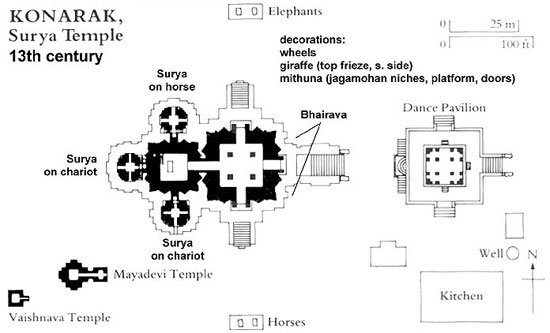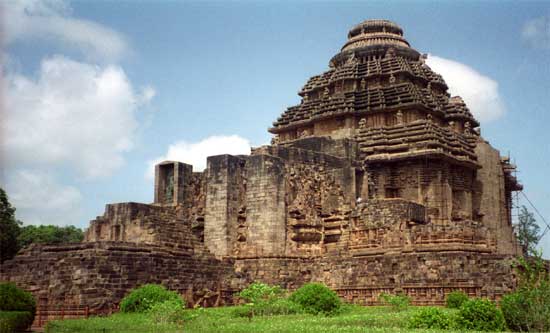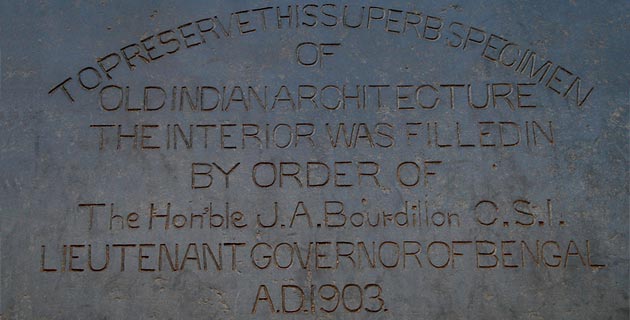

 | CLICK HERE TO VIEW SITE MENU |

|
|||||||||||||||||||||||||||||||||||||||||||||||
An Architecture Marvel of Eastern India and A symbol of India's heritage, Konark Sun Temple, commonly known as Konark is situated in the eastern state of Odisha (earlier known as Orissa), India and is one of the eminent tourist attractions. Konark houses a massive temple dedicated to the Sun God. The word 'Konark' is a combination of two words 'Kona' and 'Arka'. 'Kona' means 'Corner' and 'Arka' means 'Sun', so when combines it becomes 'Sun of the Corner'. Konark Sun Temple is situated on the north eastern corner of Puri and is dedicated to Sun God. Konark is also known as Arka khetra.
Odisha has four different khetras or regions. Legend says that after killing the demon Gyasur, Lord Vishnu placed his four Ayudhas, things that he holds in his four hands, at several places to commemorate the victory. He placed the Sankha(conch) at Puri, Chakra(disc) at Bhubaneshwar, Gada(mace) at Jajpur and Padma(lotus) at Konark. So Konark is also known as Padma khetra.
Sun Temple of Konark, built in the middle of 13th century, is a massive conception of artistic magnificence and engineering dexterity. King Narasimhadeva I, the great ruler of the Ganga dynasty had built this temple, with the help of 1200 artisans within a period of 12 years (1243-1255 A.D.). Since the ruler used to worship the Sun, the temple was considered as a chariot for the Sun God. Konark Temple was designed in the form of a gorgeously decorated chariot mounted on 24 wheels , each about 10 feet in diameter, and drawn by 7 mighty horses. It is really difficult to understand, how this huge temple, every inch-space of which was so wonderfully carved, could have been completed within such a short time. Whatever that might be, the konark temple even in its present ruined state, still a wonder to the whole world. Great poet Rabindranath Tagore wrote of Konark: "Here the language of stone surpasses the language of man".

Around the base of the temple there are images of animals, foliage, warriors on horses and other interesting structures. On the walls and roof of the temple beautiful sensual figures are carved. Sun temple of Konark is a masterpiece of Orissa's medieval architecture.
The Konark temple is widely known not only for its architectural greatness but also for the sophistication and abundance of sculptural work. Konark is an exceptional mixture of marvelous temple architecture, heritage, exotic beach and salient natural beauty. The large structure of Konark Temple seen today is actually the Jagamohana (also known as Assembly hall, Audience hall or Mukhasala) of the temple. The main temple tower which enshrined the presiding deity has fallen off and only the remains can be seen. Please visit this page to konw the possible causes of the fall of main temple tower. Even in its ruined state it is a magnificent temple reflecting the mastermind of the architects that imagined and constructed it.

Inspite of the decay over the centuries the beauty of this monument is still amazing. If you are seriously interested in architecture and sculpture then you must visit this world famous monument.
 Step to preserve the Konark Sun temple
Step to preserve the Konark Sun temple
To ensure the stability of the 13th century monument, the British (India was under British rule at that time) started major conservation work in 1901. They cleared the sand, debris and plants around the temple, which revealed the broken wheels, horses, the nata mandapa and many damaged sculptures. To avoid collapse, they took the ultimate step to preserve the Jagamohana, sealed all the entrance gates and filled the whole structure with sand. It took three years to complete this and we are fortunate enough that the Jagamohana is standing safely till date. Archaeological Survey of India took charge of the Konark temple in 1939.
To Preserve this superb specimen of old Indian Architecture the interior was filled in by order of The Hon'ble J.A.Bourdillon C.S.I. Lieutenant Governor of Bengal A.D.1903.

 Things to see in Konark temple complex
Things to see in Konark temple complex Facts about Konark temple
Facts about Konark temple UNESCO World Heritage Site
UNESCO World Heritage Site
There are 32 World Heritage Properties in India, out of which 25 are Cultural Properties and 7 are Natural Properties. The Sun Temple of Konark has been declared a Cultural world heritage site by United Nations Educational, Scientific and Cultural Organization (UNESCO) in 1984.
 Other Attractions
Other Attractions
 Satellite View of Konark Sun Temple
Satellite View of Konark Sun Temple
For how to reach Konark, where to eat & where to stay, please visit Konark Traveller Guide.